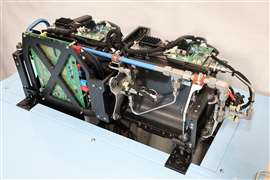Toyota shows repressurization tech for liquid hydrogen fuel systems
19 November 2024
The Toyota entry in the final round of this year’s Eneos Super Taikyu Series 2024 was the ORC Rookie GR Corolla H2 Concept.
 Le Mans prototype GR H2 Racing Concept (Photo: Toyota)
Le Mans prototype GR H2 Racing Concept (Photo: Toyota)
The H2-powered model has featured in the series since 2021. And when the organisers of the Le Mans 24 Hours endurance race said they would allow H2-fuel cars to run from 2026, Toyota was the first to unveil its prototype entry, the GR H2 Racing Concept.
So the Japanese carmaker clearly has form in this area. But also at that final round of the Eneos Super Taikyu, Toyota took the opportunity to show a prototype technology which could add to the sustainability credentials of hydrogen power.
The GE Corolla H2 Concept uses a hydrogen internal combustion engine which is fuelled from a tank of liquid hydrogen. While liquid hydrogen offers a higher energy density than compressed gas, because of the temperature difference between the fuel and ambient air it has a propensity to ‘boil off’.
That otherwise waste hydrogen gas is normally vented from the system and lost. But the prototype on display at the race meeting featured a system which could collect the boil-off gas and deliver it to a self-pressurizer which can prepare that otherwise lost fuel for use in the engine.
As the name suggests, a self-pressurizer is a device which increases pressure. In many instances, these work without using an external power source. But in this case, the unit would need more power to repressurize the boil-off hydrogen to where it would once again become liquid.
What Toyota has developed is a route to achieving that required level of repressurization of the otherwise wasted hydrogen without an external electricity supply.
The process takes a small percentage of the otherwise waste gas and sends it to a miniature fuel cell stack developed by Toyota which uses the hydrogen to produce electricity. That can then be used to power the liquid hydrogen pump and repressurize the remaining gas.
 Small FC stack that generates electricity using boil-off gas (Photo: Toyota)
Small FC stack that generates electricity using boil-off gas (Photo: Toyota)
It’s possible that the electricity produced by the fuel cell could also supplement that delivered from the alternator, further improving the overall energy efficiency of the powertrain.
In the details released by Toyota, the technology is only mentioned in terms of a racing powertrain. But it seems feasible that the process could be adapted for other applications.
For example, Toyota is producing fuel cells for light- and heavy-duty trucks. These currently use compressed hydrogen as there a still availability issues related to the liquid version. But it is efficiency-boosting tech like this which could see the more energy-dense product (and its greater range potential) move into the mainstream.
CONECTAR-SE COM A EQUIPE





